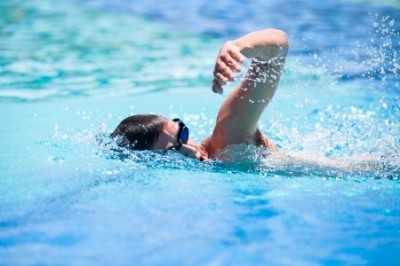Swimming With Fins

Types of Fins
First we can take a look at the types of fins and how they help:
- Traditional long blade fins – these are very commonly used by swimmers to “cheat” and travel faster in the water. They can help to some degree to improve the swimmer’s form and strengthen leg muscles, but they can also be used to increase propulsion with the least amount of work.
- Elliptical blade fins – these are comparatively new to the market but can actually be a great training and conditioning assist for swimmers. The blades are designed to improve correct propulsion through the water and work well with all of the competitive strokes including the breaststroke.
- Short blade fins – many of the variations of short blade fins can be very helpful for swim training and conditioning. Depending on the design, some short blade fins will emphasize work on the up kick as well as the down kick. This helps swimmers to improve their form. The short blade fins also work to condition and strengthen the athlete for competition. Various muscles can be exercised with these fins including hamstrings, glutes, calves and more. The fins work to keep the legs active which helps swim performance overall.
- Monofins – these unique fins can be scoffed at by some swimmers, but they provide some great training to help promote flexibility in the foot and ankle areas while helping the legs to coordinate more effectively for dolphin kicking and underwater backstroke moves.
- Very long blade fins – these are typically not used by competitive swimmers but are ideally designed for scuba diving purposes. The blades allow effective movement in the water with minimal kicks.
Who is Right?
Swimming with fins can be a very effective conditioning and training tool for beginners as well as professionals. But fins should be considered only as a tool and swimmers should not become completely dependent on the use of fins for competitive swimming. Striking a good balance by combining fin training with regular training would be the best option. This provides added muscle conditioning, improved foot and ankle flexibility and better form while also helping your body to stay independent from devices to perform.
Overall Conditioning
Competitive swimmers require a great deal of muscle conditioning to make sure they can perform well in competitions. The feet, ankles, calves, quads, hamstrings, glutes and hips are all key parts of swimming success. Care should be taken to keep your muscles safe from injury and attention given to the muscle recovery process. The Marc Pro electronic muscle stimulation device relaxes tense muscles and accelerates the muscle recovery process. Using Marc Pro as a warm-up before swimming helps prepare muscles for the workout. Afterward, Marc Pro can be used to loosen muscles and provide relief for sore areas. For additional information, please visit www.marcpro.com.